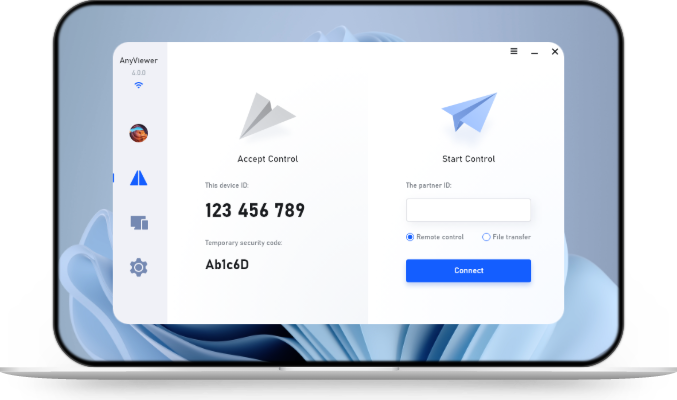How to Share Screen with Another Computer [4 Easy Ways]
In this post, we introduces 4 ways to screen share PC to PC: AnyViewer, Chrome Remote Desktop, Windows Quick Assist, and Windows Miracast. Choose the best way you like and follow the instructions to easily figure out how to share your computer screen with someone else.
How do I share my screen with another computer?
I have to work together with my team on a few projects, however, it's difficult for us to provide training sessions online because we don't discuss the same progress. Therefore, I believe that continuing the sessions on the same computer screen could be the solution to this issue. How can I share my computer screen with someone else?”
- Question from Reddit
How to share screen with another computer [4 ways]
Screen sharing between computers and screen sharing between iOS devices and computers are necessary for teamwork. Once you have shared access to your computer screen, others can view your screen activity in real time without wasting time sending files. In the post, we offer 4 ways to solve how to share computer screen to another computer. Choose one that fits your needs most.
Way 1. Share screen with another computer in Windows PCs and Servers [unattended and attended]
AnyViewer is a remote desktop software that allows you to screenshare PC with another computer in Windows 11/10/8.1/8 and Windows Server. You can also use it to share Windows computer screen with macOS/Android/ iOS devices. It is highly appreciated for the following reasons:
- Easy-to-use: With an intuitive and user-friendly interface, it enables users to establish screen sharing without limitations.
- Multi-function: In addition to screen sharing, you can transfer files, chat with the one on the other end, or manage another computer power remotely via AnyViewer.
- Free&Stable: It offers a free edition, which doesn't limit the use time and times; it is developed with 256-bit end-to-end encryption and offers two-factor authentication to ensure your stable and fast connection.
- Flexible: You can share your screen by accepting a send request if you are away from your PC and want to share your unattended PC screen with another computer.
After downloading and installing AnyViewer, follow the steps below to achieve PC screen sharing via AnyViewer.
Option 1. Share screen with another computer from local PC
Step 1. On your local PC, run AnyViewer. Get the device ID and share it with another computer.
Step 2. On another computer, run AnyViewer. Input the shared device ID and click Remote control.
Step 3. Choose the first way to send a remote control request to your local computer.
Step 4. On your local PC, you can see the request. Uncheck Allows to control the mouse and keyboard in the lower-left corner. Then, click Allow.
The remote computer can only view your PC screen but cannot run apps on your computer. Operations like changing screen resolution, transferring files, and chatting are available.
Option 2. Unattended PC screen sharing with another computer
Step 1. Run AnyViewer on both PCs. Create an AnyViewer account and log into the same account.
Step 2. On another computer, people can go to Devices, click your computer, and click View the screen to see your PC screen. Click the One-click control button if need to fix PC issues for remote support.
Notes: You can also upgrade to Professional or Enterprise plan. The following rights will thereafter be yours:
- Assign more devices to achieve screen sharing.
- Connect to the host computer in privacy mode so that you can block the remote device’s keyboard and mouse and black its screen to secure your data safety.
- Transfer unlimited files at once at a higher speed of up to 10 MB/s.
Bonus tip: How to share computer screens in one PC via AnyViewer Screen Wall
If you want to share multiple Windows PC screens simultaneously and remotely on another PC, AnyViewer offers a powerful function called Screen Wall to display all the remote screens in a single window in real time. Here's how to share desktop screens remotely.
Step 1. Go to the Device interface and click your local PC. Then choose the Screen wall function on the right.
Step 2. In the pop-up window, click the Create screen wall button.
Step 3. Choose the remote devices from your devices list, and click Add to add all these device screens to your Screen Wall.
Step 4. Open your Screen Wall and all the real-time actions of the remote screens will be displayed on your PC.
Way 2. Share screen with another PC in Windows 11/10 [attended]
If both computers are running Windows 10 1607 or later version, you can use Quick Assist to share screen with another computer without downloading third-party software.
Step 1. On the computer with which you want to share your screen, type in Quick Assist in the search box and open it. Click Assist another person in the main interface.
Step 2. Enter your Microsoft account and click Next to get the share security code. And then, input the password and click Sign in. Then the security code will appear, valid only for 10 minutes.
Step 3. On your computer, open Quick Assist, input the security code, and then click Share screen.
Step 4. Choose Full Control or View Screen based on your own need, and click Continue.
Step 5. Click Allow to share your screen with another computer.
Way 3. How to share PC screen to another PC using WiFi via Windows Miracast
When both computers are connected to the same WiFi and running Windows 10 or 11, you can usemMiracast a built-in feature available on Windows 10/11.
Operation 1. Check whether or not your PC is Miracast compatible
Step 1. Press Win + P to evoke the projection options.
Step 2. If you see an option at the bottom that says "Connect to a wireless display," your PC is Miracast compatible.
Operation 2. Share PC screen with another PC via Miracast
Before using Miracast, make sure both computers are connected to a WiFi network.
Step 1. Open the Action center in the bottom right corner of the desktop.
Step 2. Click Connect to see your devices.
Step 3. Select the receiving device to establish screen sharing and wait for the devices to pair. You need to try again if the connection fails.
Step 4. Tick Allow input if you want to let the receiving computer control your PC.
Step 5. Click Change projection mode to select a mode that fits your needs.
Step 6. Click Disconnect when you want to end your screen sharing.
Way 4. Share screen with another computer in Windows, Linux, or ChromeOS over the internet
If your computer or another computer is running Windows and both computers are pre-installed with Chrome browser, Chrome Remote Desktop can be your best choice to share screen. It is available for Microsoft Windows, OS X, Linux, and ChromeOS.
Step 1. Sign in to the same Google Account on both devices and open the Chrome Remote Desktop download page. Select Remote Support on the left pane on your PC and then click the blue download button.
Step 2. Click Add to Chrome to add Chrome Remote Desktop extension to your Chrome browser.
Step 3. Click Add extension in the pop-up window to confirm the download.
Step 4. After adding the Chrome Remote Desktop extension, click + Generate Code under Share this screen.
Step 5. Send the generated code to the PC with which you want to share the computer screen (the code will expire in 5 minutes).
Step 6. On the remote computer, enter the access code of the host PC and then click Connect.
Step 7. A request will appear on your computer, and click Share to establish screen sharing.
Conclusion
Now, you must have grasped how to share screen with another computer. For how to screen share with another computer flexibly in Windows, AnyViewer is your best solution. For how to share screen remotely in Windows 11/10 without downloading a third-party tool, Quick Assist or Miracast are acceptable. For sharing computer screen with another computer in Mac or Linux, Chrome Remtoe Desktop can be helpful!
FAQs
How do I share my screen on any platform using AnyViewer?
To initiate screen sharing, send an outbound session request to the target device using AnyViewer Device ID. By default, screen sharing is enabled across all platforms. For a session that exclusively shares the screen without additional features, the recipient can adjust permissions in the acceptance window. Alternatively, the session initiator can configure a custom client with limited access.
What is screen sharing between devices?
Screen sharing between devices is a technology that allows one device to display its screen on another device in real time. This enables users to view, control, or collaborate on tasks remotely. It is commonly used for remote assistance, online meetings, presentations, and troubleshooting technical issues.
Who can use screen sharing?
Anyone can use screen sharing, including individuals, businesses, educators, and IT support teams. It is useful for remote work, online meetings, presentations, and technical assistance.
Is screen sharing safe?
Screen sharing is generally safe when used with secure software and trusted connections. To enhance security, use strong passwords, enable encryption, and restrict access to authorized users. Avoid sharing sensitive information during sessions.

